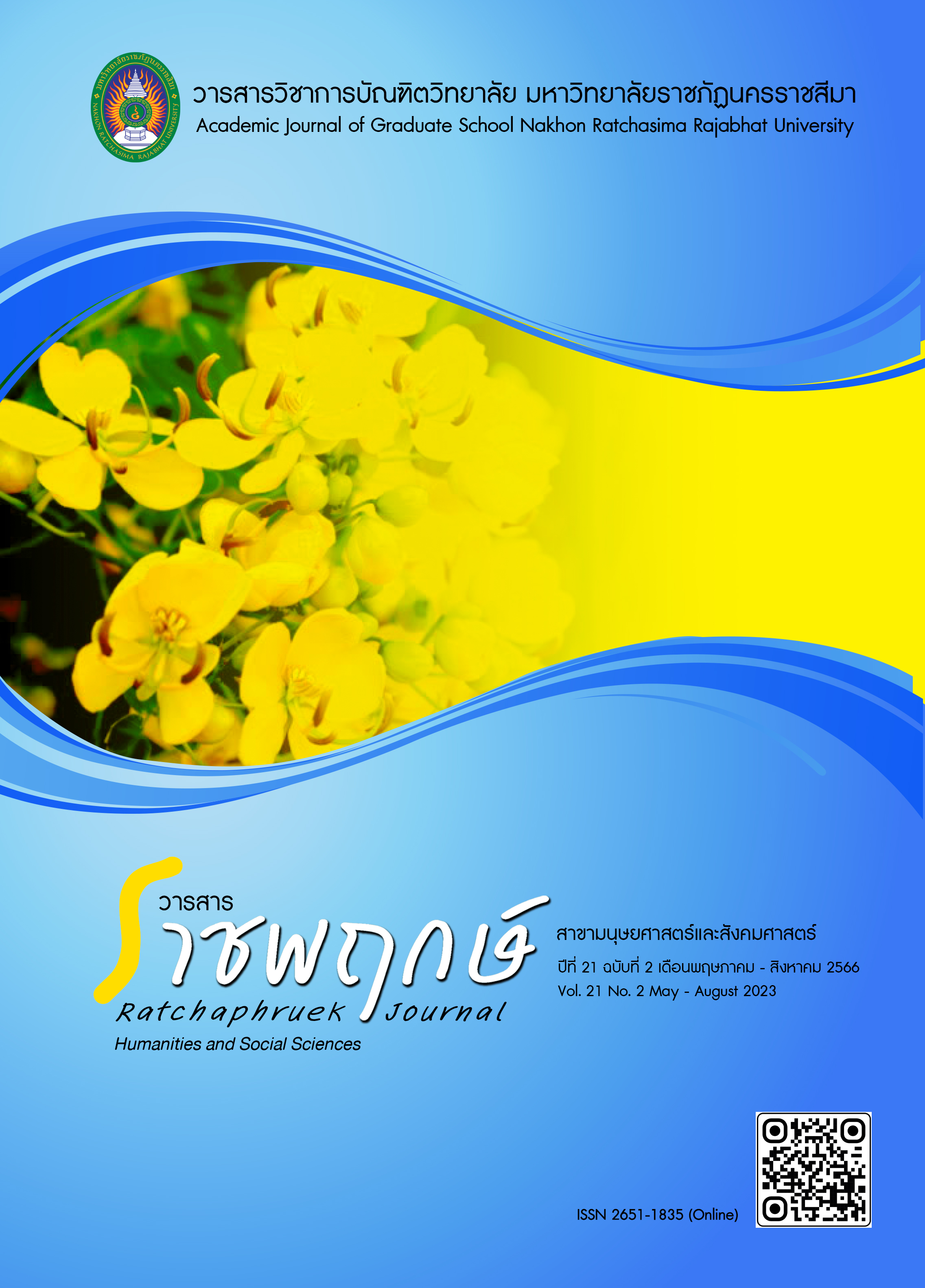แนวทางการยกระดับทุนทางวิชาชีพครู เพื่อพัฒนาสมรรถนะการคิดขั้นสูงของผู้เรียน ตามหลักสูตรฐานสมรรถนะ ในโรงเรียนมัธยมศึกษา สหวิทยาเขตราชบุรี 1
Main Article Content
บทคัดย่อ
งานวิจัยนี้เป็นการศึกษาแนวทางในการยกระดับทุนทางวิชาชีพครู เพื่อพัฒนาสมรรถนะการคิดขั้นสูงของผู้เรียน ตามหลักสูตรฐานสมรรถนะ ในโรงเรียนมัธยมศึกษา โดยมีวัตถุประสงค์เพื่อ 1) ศึกษาสภาพปัจจุบัน สภาพที่พึงประสงค์และความต้องการจำเป็นในการยกระดับทุนทางวิชาชีพครู กลุ่มตัวอย่าง คือ ครู จำนวน 181 คน โรงเรียนมัธยมศึกษาสหวิทยาเขตราชบุรี 1 จากการสุ่มตัวอย่างแบบหลายขั้นตอน เครื่องมือที่ใช้ คือ แบบสอบถามสภาพปัจจุบันและสภาพที่พึงประสงค์ในการยกระดับทุนทางวิชาชีพครูฯ; 2) วิเคราะห์สาเหตุที่ทำให้เกิดความต้องการจำเป็นฯ ด้วยการสัมภาษณ์ผู้บริหารสถานศึกษาและครู จำนวน 10 ท่าน เครื่องมือที่ใช้ คือ แบบสัมภาษณ์ แบบกึ่งโครงสร้าง แล้ววิเคราะห์ Empathy map; และ 3) สังเคราะห์แนวทางการยกระดับทุนทางวิชาชีพครูฯ ด้วยการวิเคราะห์เนื้อหาจากการสัมภาษณ์ผู้บริหารสถานศึกษาและครู จำนวน 10 ท่าน โดยสังเคราะห์ร่วมกับผลการวิจัยจากขั้นตอนที่ 1 และ 2
ผลการวิจัย พบว่า 1) ความต้องการจำเป็นลำดับที่ 1 คือ ด้านทุนมนุษย์ (PNImodified = 0.145) 2) สาเหตุที่ทำให้เกิดความต้องการจำเป็นฯ คือ ครูใช้วิธีการจัดการเรียนรู้ที่ไม่ส่งเสริมการพัฒนาสมรรถนะการคิดขั้นสูง ขาดความตระหนักถึงความสำคัญของสมรรถนะการคิดขั้นสูง และขาดการเชื่อมโยงองค์ความรู้ให้สอดคล้องกับสถานการณ์จริงในชีวิต และ 3) แนวทางการยกระดับทุนทางวิชาชีพครูฯ คือ ผู้บริหารสถานศึกษา เพื่อนครู ศึกษานิเทศก์ มีการนิเทศ ติดตาม ให้คำแนะนำวิธีการจัดการเรียนรู้ที่ส่งเสริมสมรรถนะการคิดขั้นสูง
Article Details

อนุญาตภายใต้เงื่อนไข Creative Commons Attribution-NonCommercial-NoDerivatives 4.0 International License.
เอกสารอ้างอิง
กระทรวงศึกษาธิการ. (2565). ประกาศกระทรวงศึกษาธิการ เรื่อง นโยบายและจุดเน้นของ กระทรวงศึกษาธิการ ประจำปีงบประมาณ พ.ศ. 2566. สืบค้นเมื่อ 10 พฤษภาคม 2566, จาก https://www.moe.go.th/360policy-and-focus-moe-2023/
โชติกา ใจทิพย์ และกฤษดา เชียรวัฒนสุข. (2561). ศักยภาพของผู้นำองค์กรธุรกิจในสถานการณ์โลกที่มีความผันผวน ความไม่แน่นอน ความซับซ้อน และความคลุมเครือ. วารสารการจัดการธุรกิจ มหาวิทยาลัยบูรพา, 7(1), น. 1-14.
ปรียาภรณ์ ตั้งคุณานันต์. (2561). ความเป็นครูมืออาชีพ. กรุงเทพฯ: มีน เซอร์วิส ซัพพลาย.
ไพฑูรย์ สินลารัตน์ และนักรบ หมี้แสน. (2560). ครุศึกษาและการพัฒนาวิชาชีพครู. กรุงเทพฯ: จุฬาลงกรณ์มหาวิทยาลัย.
มานิตย์ อาษานอก. (2561). การบูรณาการกระบวนการคิดเชิงออกแบบเพื่อพัฒนานวัตกรรมการจัดการเรียนรู้. วารสารเทคโนโลยีและสื่อสารการศึกษา, 1(1), น. 6-12.
สำนักงานเขตพื้นที่การศึกษามัธยมศึกษาราชบุรี. (2566). แผนพัฒนาการศึกษาขั้นพื้นฐาน (พ.ศ. 2566-2570). สืบค้นเมื่อ 28 มีนาคม 2566, จาก https://drive.google.com/file/d/1e4OoncN5NHr1Eek16LbW_tutw6Y91g_9/view
สำนักงานคณะกรรมการการศึกษาขั้นพื้นฐาน. (2564). พฤติกรรมบ่งชี้หลักตามระดับสมรรถนะการคิดขั้นสูง. สืบค้นเมื่อ 10 พฤษภาคม 2566, จาก https://cbethailand.com/หลักสูตร/หลักสูตรฐานสมรรถนะ/สมรรถนะหลัก-5-ประการ/สมรรถนะการคิดขั้นสูง/พฤติกรรมบ่งชี้พฤติกรรม/
สำนักงานคณะกรรมการข้าราชการครูและบุคลากรทางการศึกษา. (2564). คู่มือการดำเนินการตามหลักเกณฑ์และวิธีการประเมินตำแหน่งและวิทยาฐานะข้าราชการครูและบุคลากรทางการศึกษา ตำแหน่งครู. สืบค้นเมื่อ 5 เมษายน 2566, จาก https://otepc.go.th/ images/00YEAR 2564/03_PV1/1Mv9-2564.pdf
สำนักงานศึกษาธิการจังหวัดราชบุรี. (2563). แผนพัฒนาการศึกษาจังหวัดราชบุรี พ.ศ. 2562-2565 ฉบับทบทวน ปี พ.ศ. 2563. สืบค้นเมื่อ 28 มีนาคม 2566, จาก http://plan.mcru. ac.th/ Work/Manual/PSH/62-65-SP.pdf
สุวิมล ว่องวาณิช. (2558). การวิจัยประเมินความต้องการจำเป็น (พิมพ์ครั้งที่ 3). กรุงเทพฯ: จุฬาลงกรณ์มหาวิทยาลัย.
อังคณา อ่อนธานี. (2564). การพัฒนาสมรรถนะการจัดการเรียนรู้ของครูเพื่อส่งเสริมการคิดขั้นสูงสำหรับผู้เรียนชั้นมัธยมศึกษา. วารสารศึกษาศาสตร์ มหาวิทยาลัยนเรศวร, 23(4), น. 406-418.
Bennett, N. & Lemoine, G. J. (2014). What a difference a word makes: Understanding threats to performance in a VUCA world. Business Horizons, 57(3), pp. 311-317.
Cronbach, L. J. (1951). Coefficient alpha and the internal structure of tests. Psychometrika, 16(3), pp. 297-334.
Hargreaves, A. & Fullan, M. (2012). Professional capital: Transforming teaching in every school. New York: Teachers College Press.
Krejcie, R. V. & Morgan, D. W. (1970). Determining Sample Size for Research Activities. Educational and Psychological Measurement, 30(3), pp. 607-610.
Likert, S. (1961). New patterns of management. New York: McGraw-Hill.
Miedijensky, S., Sasson, I. & Yehuda, I. (2021). Teachers’ Learning Communities for Developing High Order Thinking Skills-A Case Study of a School Pedagogical Change. Interchange, 52(1), pp. 577-598.


